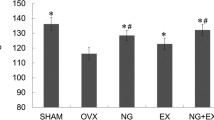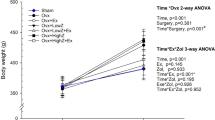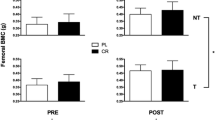Abstract
It has been reported that alfacalcidol had an anticatabolic and anabolic effect on bone in ovariectomized and aged male rat models, but this has not been tested on intact female rats. The current study was to determine the effects of alfacalcidol on cancellous and cortical bone in intact female rats with or without exercise. Seventy-four, 8.5-month-old, intact female rats were orally treated with 0, 0.005, 0.025, 0.05, or 0.1 μg/kg alfacalcidol alone or in combination with raised cage (RC) exercise for 3 months. In vivo peripheral quantitative computerized tomography (pQCT) of the proximal tibial metaphyses (PTM) and ex vivo histomorphometric analyses of the PTM and tibial shaft (TX) were performed. Only the 0.1 μg alfacalcidol/kg dose proved to be anabolic. pQCT analysis showed that this dose increased total and cortical bone mineral content and density and trabecular bone mineral density. Histomorphometrically, it induced an anabolic response by increased trabecular mass and microarchitecture from stimulated cancellous bone and bone bouton formations, and suppressed bone resorption more than bone formation on the trabecular and endocortical surfaces, to produce a positive bone balance. A positive correlation between trabecular connectivity and bone bouton numbers occurred. These findings suggest alfacalcidol treatment augments bone mass by increased cancellous bone mass and improved trabecular architecture through its anticatabolic and anabolic properties in the intact adult female rat. Last, raised cage exercise alone or the combination of raised cage and alfacalcidol was no more effective than alfacalcidol alone.
Similar content being viewed by others
References
Lane NE (2006) Epidemiology, etiology, and diagnosis of osteoporosis. Am J Obstet Gynecol 194(suppl):S3–S11
Larijani B, Moayyeri A, Keshtkar AA, Hossein-Nezhad A, Soltani A, Bahrami A, Omrani GH, Rajabian R, Nabipour I (2006) Peak bone mass of Iranian population: the Iranian Multicenter Osteoporosis study. J Clin Densitom 9:367–374
Fujiwara S (2005) Epidemiology of osteoporosis. Clin Calcium 15:577–582
Shiraishi A, Takeda S, Masaki T, Higuchi Y, Uchiyama Y, Kubodera N, Sato K, Ikeda K, Nakamura T, Matsumoto T, Ogata E (2000) Alfacalcidol inhibits bone resorption and stimulates formation in an ovariectomized rat model of osteoporosis: distinct actions from estrogen. J Bone Miner Res 15:770–779
Shiraishi A, Higashi S, Ohkawa H, Kubodera N, Hirasawa T, Ezawa I, Ikeda K, Ogata E (1999) The advantage of alfacalcidol over vitamin D in the treatment of osteoporosis. Calcif Tissue Int 65:311–316
Li M, Li Y, Healy DR, Simmons HA, Ke HZ, Thompson DD (2003) Alfacalcidol restores cancellous bone in ovariectomized rats. J Musculoskelet Neuronal Interact 3:39–46
Weber K, Kaschig C, Erben RG (2004) 1α-Hydroxyvitamin D2 and 1α-hydroxyvitamin D3 have anabolic effects on cortical bone, but induce intracortical remodeling at toxic doses in ovariectomized rats. Bone (NY) 3535:704–71
Weber K, Goldberg M, Stangassinger M, Erben RG (2001) 1α-Hydroxyvitamin D2 is less toxic but not bone selective relative to 1α-hydroxyvitamin D3 in ovariectomized rats. J Bone Miner Res 16:639–65
Li M, Healy DR, Li Y, Simmons HA, Su M, Jee WSS, Shen VW, Thompson DD (2004) Alfacalcidol prevents age-related bone loss and causes an atypical pattern of bone formation in aged male rats. J Musculoskelet Neuronal Interact 4:22–32
Erben RG, Brown S, Stangassinger M (1998) Therapeutic efficacy of 1α, 25-dihydroxyvitamin D3 and calcium in osteopenia ovariectomized rats: evidence for a direct anabolic effect of 1α, 25-dihydroxyvitamin D3 on bone. Endocrinology 139:4319–4328
Eastell R, Riggs BL (1997) Vitamin D and osteoporosis. In: Feldman D, Glorieux FH, Pike JW (eds) Vitamin D. Academic Press, New York, pp 695–711
Erben RG (2001) Vitamin D analogs and bone. J Musculoskelet Neuronal Interact 2:59–69
Frost HM (1992) Perspectives: the role of changes in mechanical usage set point in the pathogenesis of osteoporosis. J Bone Miner Res 7:253–262
Frost HM (1990) Skeleton structural adaptation to mechanical usage (SATMU). Redefining Wolff’s law: the bone modeling problem. Anat Rec 266:403–413
Iwamoto J, Shimamura C, Takeda T, Abe H, Ichimura S, Sato Y, Toyama Y (2004) Effects of treadmill exercise on bone mass, bone metabolism, and calciotropic hormones in young growing rats. J Bone Miner Metab 22:26–31
Yeh JK, Liu CC, Aloia JF (1993) Additive effect of treadmill exercise and 17-estradiol replacement on prevention of tibial bone loss in adult ovariectomized rat. J Bone Miner Res 8:677–683
Mosley JR, Lanyon LE (2002) Growth rate rather than gender determines the size of the adaptive response of the growing skeleton to mechanical strain. Bone (NY) 30:314–319
Jee WSS (2000) Anabolic agents and osteoporosis: quo vadis. J Musculoskelet Neuronal Interact 1:107–111
Kalu DN, Banu J, Wang L (2000) How cancellous and cortical bones adapt to loading and growth hormone. J Musculoskelet Neuronal Interact 1:19–23
Jee WSS, Tian XY (2005) The benefit of combining nonmechanical agents with mechanical loading: a perspective based on the Utah Paradigm of skeletal physiology. J Musculoskelet Neuronal Interact 5:110–118
Yao W, Jee WSS, Chen JL, Li CY, Frost HM (2001) A novel method to “exercise” rats: making rats rise to erect bipedal stance for feeding-raised cage model. J Musculoskelet Neuronal Interact 1:241–247
Yao W, Jee WSS, Chen JL, Liu HY, Tam CS, Cui L, Zhou H, Setterberg RB, Frost HM (2000) Making rats rise to erect bipedal stance for feeding partially prevented orchidectomy-induced bone loss and added bone to intact rats. J Bone Miner Res 15:1158–1168
Yao W, Jee WSS, Chen JL, Tam CS, Setterberg RB, Frost HM (2000) Erect bipedal stance exercise partially prevents orchidectomy-induced bone loss in the lumbar vertebrae of rats. Bone (NY) 27:667–675
Chen JL, Yao W, Frost HM, Li CY, Setterberg RB, Jee WSS (2001) Bipedal stance exercise enhances antiresorption effects of estrogen and counteracts its inhibitory effect on bone formation in sham and ovariectomized rats. Bone (NY) 29:126–133
Li CY, Jee WSS, Chen JL, Mo A, Setterberg RB, Su M, Tian XY, Ma YF, Yao W (2003) Estrogen and “exercise” have a synergistic effect in preventing bone loss in the lumbar vertebra and femoral neck of the ovariectomized rat. Calcif Tissue Int 72:42–49
Mo A, Yao W, Li C, Tian X, Su M, Ling Y, Zhang Q, Setterberg RB, Jee WSS (2002) Bipedal stance exercise and prostaglandin E2 (PGE2) and its synergistic effect in increasing bone mass and in lowering the PGE2 dose required to prevent ovariectomized-induced cancellous bone loss in aged rats. Bone (NY) 31:402–406
Shiraishi A, Higashi S, Masaki T, Saito M, Ito M, Ikeda S, Nakamura T (2002) A comparison of Alfacalcidol and Menatetrenone for the treatment of bone loss in an ovariectomized rat model of osteoporosis. Calcif Tissue Int 71:69–79
Compston JE, Mellish RWE, Croucher P, Newcombe R (1989) Structural mechanisms of trabecular bone loss in man. Bone Miner 6:339–350
Tang LY, Jee WSS, Ke HZ, Kimmel DB (1992) Restoring and maintaining bone in osteopenic female rat skeleton: I. Changes in bone mass and structure. J Bone Miner Res 7:1093–1104
Riggs BL, Parfitt AM (2004) Drugs used to treat osteoporosis: the critical need for a uniform nomenclature based on their action on bone remodeling. J Bone Miner Res 20:177–184
Jee WSS, Li XJ (1989) Adaptation of cancellous bone to overloading in the adult rat: A single photon absorptiometry and histomorphometry study. Anat Rec 227:418–426
Li XJ, Jee WSS, Ke HZ, Mori S, Akamine T (1991) Age-related changes of cancellous and cortical bone histomorphometry in female Sprague-Dawley rats. Cells Materials Suppl 1:25–35
Hauge E, Mosekilde LE, Melsen F (1999) Missing observations in bone histomorphometry on osteoporosis: implications and suggestions for an approach. Bone (NY) 25:389–395
Parfitt AM (2002) Recent contributions of iliac bone histomorphometry to understanding the anabolic effect of parathyroid hormone. BoneKEy-Osteovision 1:2002017
Ma YF, Donley W, Eriksen EF (2003) Characteristics of modeling and remodeling osteons after teriparatide treatment. Bone 32: S225
Kobayashi S, Takahashi HE, Ito A, Santo N, Nawata M, Horiuchi H, Ohta H, Ito A, Iorio R, Yamamoto N, Takaoka K (2003) Trabecular minimodeling in human iliac bone. Bone (NY) 32:163–169
Lindsay R, Cosman F, Zhou H, Bostrom MP, Shen VW, Cruz JD, Nieves JW, Dempster DW (2006) A novel tetracycline labeling schedule for longitudinal evaluation of the short-term effects of anabolic therapy with a single iliac crest bone biopsy: early actions of Teriparatide. J Bone Miner Res 21:366–373
Ma YL, Zeng QQ, Donley DW, Ste-Marie LG, Gallagher JC, Dalsky GP, Marcus R, Eriksen EF (2006) Teriparatide increase bone formation in modeling and remodeling osteons and enhances IGF-II immunoreactivity in postmenopausal women with osteoporosis. J Bone Miner Res 21:855–864
Chen HY, Tian XY, Liu XQ, Setterberg RB, M. Li M, Jee WSS (2008) Alfacalcidol stimulated focal bone formation on the cancellous surface and increased bone formation on the periosteal surface at the lumbar vertebra of adult female rats. Calcif Tissue Int 82: 127–136
Saxon LK, Turner CH (2006) Low-dose estrogen treatment suppresses periosteal bone formation in response to mechanical loading. Bone (NY) 39:1261–1267
Erben RG (2000) Skeletal effects of androgen withdrawal. J Musculoskelet Neuronal Interact 1:223–233
Runge M, Schacht E (2005) Multifactorial pathogenesis of falls as a basis for multifactorial intervention. J Musculoskelet Neuronal Interact 5:127–134
Schacht E, Richy F, J-Y Reginster (2005) The therapeutic effects of alfacalcidol on bone strength, muscle metabolism and prevention of falls and fractures. J Musculosket Neuronal Interact 5:273–284
Author information
Authors and Affiliations
Corresponding author
About this article
Cite this article
Liu, X.Q., Chen, H.Y., Tian, X.Y. et al. Alfacalcidol treatment increases bone mass from anticatabolic and anabolic effects on cancellous and cortical bone in intact female rats. J Bone Miner Metab 26, 425–435 (2008). https://doi.org/10.1007/s00774-008-0854-4
Received:
Accepted:
Published:
Issue Date:
DOI: https://doi.org/10.1007/s00774-008-0854-4




